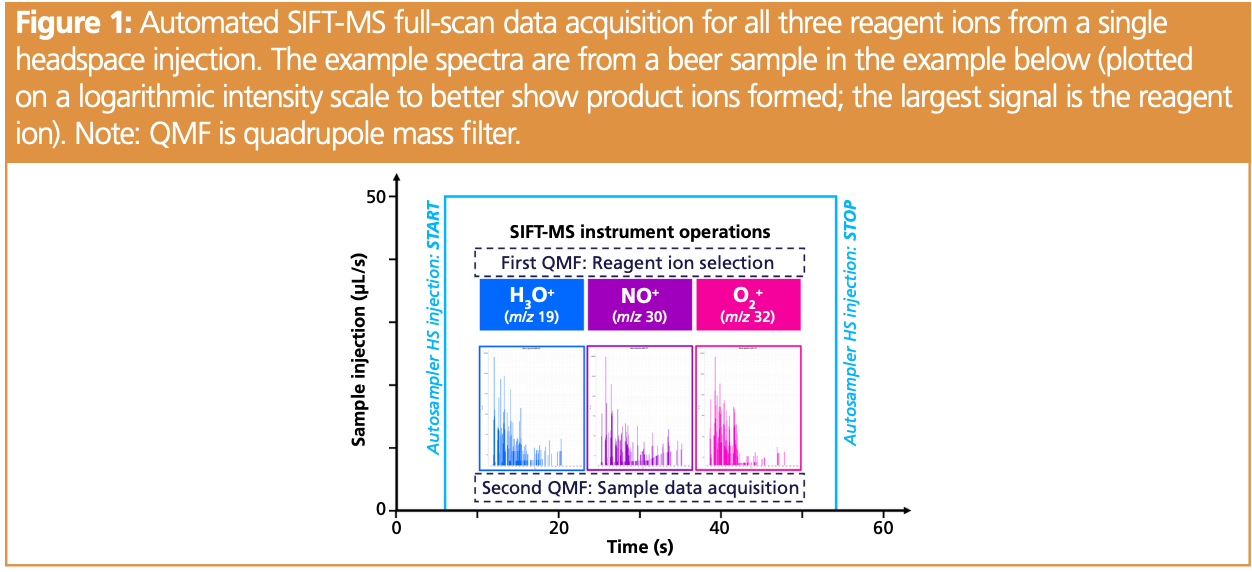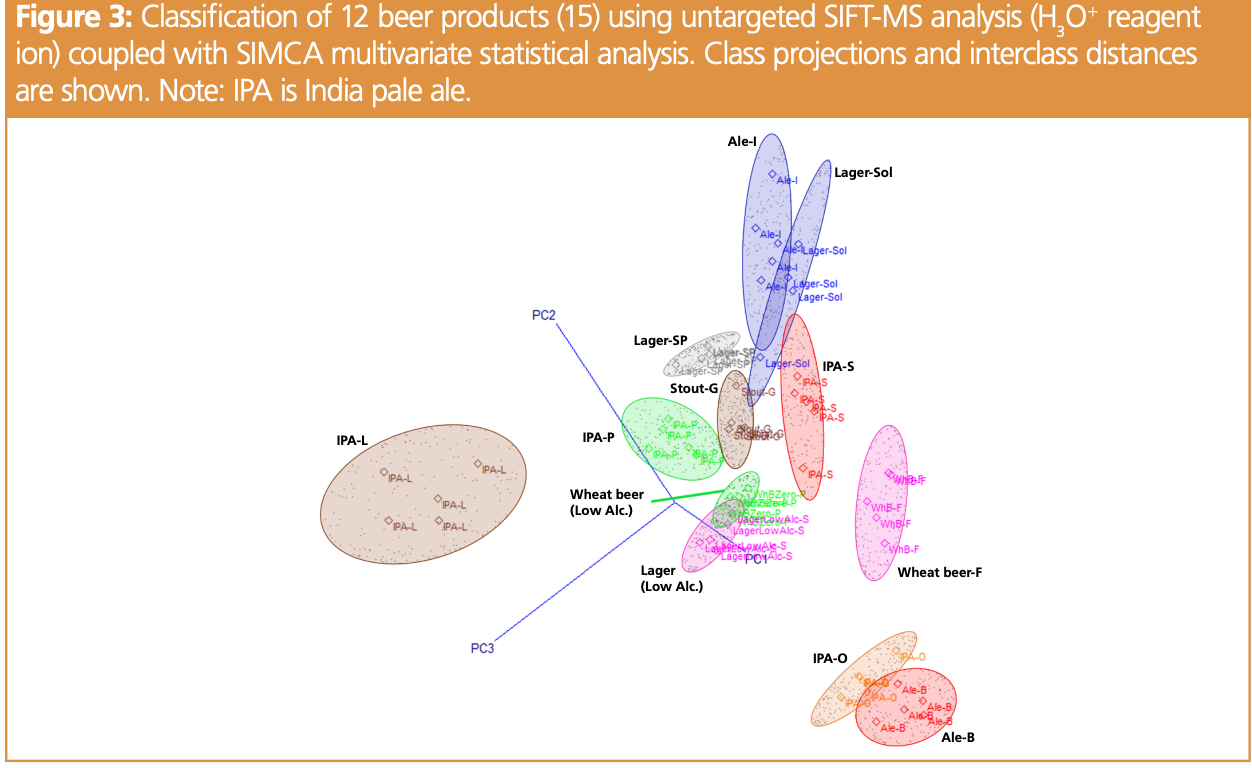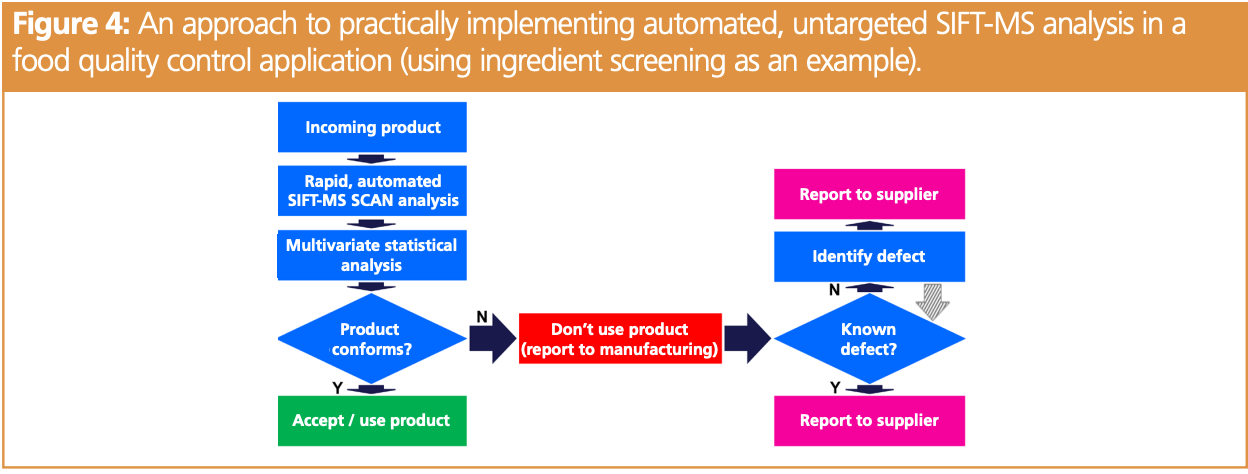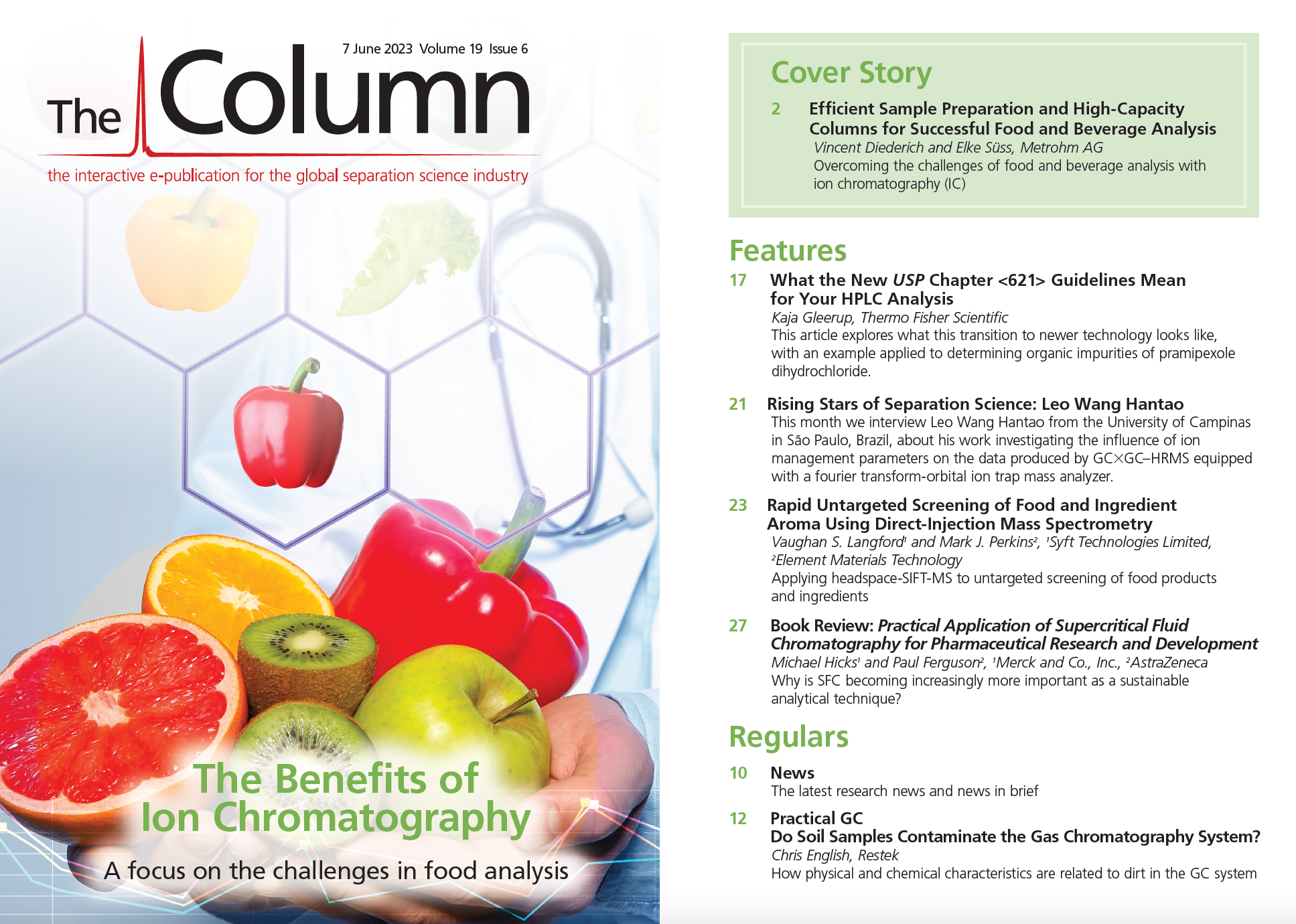Rapid Untargeted Screening of Food and Ingredient Aroma Using Direct-Injection Mass Spectrometry
Applying headspace-SIFT-MS to untargeted screening of food products and ingredients.
Food product and ingredient analysis using selected ion flow tube mass spectrometry (SIFT-MS), like other direct-injection mass spectrometry (DIMS) techniques, has most commonly used a targeted approach. However, DIMS techniques can also be utilized in untargeted mode for broader profiling of volatile “fingerprints” that can then be processed using multivariate statistical methods to classify according to manufacturer, origin, and quality. This article surveys the application of headspace-SIFT-MS to untargeted screening of food products and ingredients, such as beer, olive oil, Parmesan cheese, and strawberry flavour mixes. Rapid quality assurance/quality control (QA/QC) screening of up to 250 samples a day can be conducted.
Aroma consistency is important to brand value because it contributes to consumer acceptance of foods and beverages. However, traditional screening using a trained sensory panel is expensive. Viable instrumental alternatives for determining acceptance are few due to various practical limitations:
- The gold-standard volatile organic compound (VOC) analysis methods—gas chromatography (GC), gas chromatography-olfactometry (GC-O), and liquid chromatography (LC)—are slow and can require significant sample preparation, including derivatization for short-chain aldehydes and volatile fatty acids.
- Electronic noses—usually based on metal oxide sensor arrays—are subject to significant drift, are susceptible to contamination (for example, from ethanol residues), and cannot identify individual flavour components.
Close up of beer | Image Credit: © Norbert - stock.adobe.com

Selected ion flow tube mass spectrometry (SIFT-MS), on the other hand, is a direct-injection mass spectrometry (DIMS) technique that eliminates chromatography and applies soft chemical ionization to rapid, direct analysis of headspace samples. SIFT-MS has conventionally been used for targeted analysis of aroma volatiles (1), but untargeted analysis is increasingly adopted (2). Untargeted analysis is ideal for product screening applications because it can detect product changes that a targeted approach may miss. When coupled with statistical processing, the SIFT-MS data provide an “aroma print” of ingredients and finished products that can support quality assurance (QA) and quality control (QC). This article outlines the steps involved in generating the SIFT-MS “aroma print”, offers examples of its application, and concludes by considering a practical workflow that complements chromatographic methods.
Experimental
This section summarizes the experimental steps involved in generating the SIFT-MS “aroma print”.
Sample Preparation
Food and beverage samples (whether the finished product or ingredient) were placed in a headspace vial (usually 20 mL) and incubated (temperature and time depend on product) in preparation for headspace sampling and analysis. No extraction or derivatization was required.
Analytical Methodology
The SIFT-MS technique has recently been reviewed in detail (1). Briefly, rapidly switchable reagent ions (H3O+, NO+, and O2+) are utilized for gas-phase soft chemical ionization of trace VOCs in air and headspace. Real-time, high-throughput analysis is realized because SIFT-MS is chromatography-free, while selectivity is achieved through the combination of multiple ionization mechanisms of the rapidly switchable reagent ions coupled with mass spectrometric detection (2). A SIFT-MS instrument was used in this work (Voice200ultra, Syft Technologies). Automated headspace-SIFT-MS analysis (3) was conducted using a syringe-injection autosampler (MPS Robotic Pro, Gerstel). For full-scan analysis of headspace, sampling typically utilized a 2.5-mL headspace syringe (Gerstel) (heated to 150 °C) followed by injection (at 50 μL/s) into the SIFT-MS instrument’s heated autosampler inlet (150 °C) via a self-sealing sampling head. Since the nominal sample flow into the SIFT-MS instrument is 420 μL/s, a make-up gas flow (ultra-high purity nitrogen or zero air) was also introduced through the sampling head. In practice, about 40 s of data acquisition time was available during sample injection, which facilitated sensitive full-scan analysis using all three positively charged reagent ions (Figure 1). Note, however, that the same configuration and mode of sample delivery applies to a wide variety of targeted food analyses.

Multivariate Statistical Analysis of SIFT-MS Data
SIFT-MS full-scan data are usually variable-rich (mass-to-charge ratios, m/z) compared to the number of samples used to build the classification- or discrimination-based model. Hence chemometric methods are most applicable. Multivariate statistical analysis has typically been conducted using soft independent modelling by class analogy (SIMCA) (4,5), a classification approach (Pirouette software [v4.5], Infometrix, Inc.). Three key metrics of the SIMCA algorithm are typically discussed (6):
- Class projections are three-dimensional plots that show how samples fall with respect to the three most important principal components derived from the underlying principal component analysis (PCA). Classes are user-defined (for a given origin, quality, or sensory attribute) in building the statistical model. Larger visual separations of classes usually indicate that more confident assignment of unknown samples to a predefined class will be possible (if a suitable class exists in the model).
- Interclass distances measure theseparation between classes, with a value ≥3 usually considered separable (5).Sometimes the class separability indicatedby these distances is not apparent in the three-dimensional class projection plot.
- Discriminating power identifies variables that provide the most discrimination between the classes, with larger values having greater influence on class separation.
Coupled with headspace-SIFT-MS analysis, online statistical analysis can provide rapid feedback for routine product screening, as shown schematically in Figure 2.

Food and Beverage Screening Applications
Vercammen and co-workers have pioneered untargeted SIFT-MS food analysis in the literature, demonstrating origin authentication of high-value argan and olive oils and adulteration detection in argan oil (7,8,9). Recently, Geffroy and co-workers have classified wine grapes as a function of ripeness (10,11). The approach has also been utilized for classification of commercial strawberry flavour mixes for intra-mix (batch) and inter-mix variations (12), and Parmesan cheeses by manufacturer (13). An analogous approach can also be applied to packaging materials, as demonstrated recently for virgin and recycled HDPE (14).
Untargeted analysis has also been applied to beverages, such as 12 beer products investigated recently (15). It is important to note that, due to the ethanol content in beer, it was necessary to dilute test samples 10-fold in water to bring the total headspace VOC concentration within the dynamic range of the SIFT-MS instrument. Figure 3 summarizes the results obtained when SIFT-MS full-scan data acquired using the H3O+ reagent ion were processed using the SIMCA algorithm. The H3O+ reagent ion distinguished all beer products (interclass distance >3 [5]). When beer types were grouped by type, the H3O+ reagent ion completed near-perfect classification. Full details are given in reference 15.

Practical Implementation of SIFT-MS Screening
SIFT-MS provides a new, rapid approach to untargeted screening (“aroma printing”) of ingredients and food and beverage products for aroma consistency when it is coupled with multivariate statistical analysis. Figure 4 proposes a simple workflow for implementation of SIFT-MS-based product screening in food manufacturing QA/QC, using ingredient screening as an example application. As shown in Figures 1 and 2, SIFT-MS offers a rapid answer on ingredient or product conformity (left-hand side of Figure 4). SIFT-MS may also be able to identify the defect(s). However, for comprehensive analysis, a more rigorous approach applies GC- and/or LC-based techniques.

Conclusion
Untargeted SIFT-MS screening of food and beverage products is in its infancy, but it shows great potential due to the simplicity of sample preparation, ease of use, and speed to result. In combination, these attributes enable fast decision-making by QA/QC management.
References
(1) Smith, D.; Španěl, P.; Demarais, N.; Langford, V. S.; McEwan, M. J. Recent Developments and Applications of [SIFT-MS]. Mass Spec. Rev. 2023, e21835. DOI: 10.1002/mas.21835
(2) Langford, V. S. SIFT-MS: Quantifying the Volatiles You Smell . . . and the Toxics You Don’t. Chemosensors 2023, 11, 111. DOI: 10.3390/chemosensors1102011
(3) Perkins, M. J.; Langford, V. S. Application of Routine Analysis Procedures to a Direct Mass Spectrometry Technique: [SIFT-MS]. Rev. Sep. Sci. 2021, 3 (2), e21003. DOI: 10.17145/rss.21.003
(4) Wold, S. Pattern Recognition by Means of Disjoint Principal Components Models. Pattern Recognit. 1976, 8, 127–139. DOI: 10.1016/0031-3203(76)90014-5
(5) Kvalheim, O. M.; Karstang, T. V. SIMCA – Classification by Means of Disjoint Cross Validated Principal Components Models. In Multivariate Pattern Recognition in Chemometrics, Illustrated by Case Studies; Brereton, R. D., Ed.; Elsevier, 1992; pp 209–238.
(6) Langford, V. S.; Padayachee, D.; McEwan, M. J.; Barringer, S. A. Comprehensive Odorant Analysis for On-Line Applications Using [SIFT-MS]. Flavour Fragr. J. 2019, 34 (6), 393–410. DOI: 10.1002/ffj.3516
(7) Kharbach, M.; Kamal, R.; Mansouri, A. M.; et al. [SIFT-MS] Fingerprinting Versus Chemical Profiling for Geographic Traceability of Moroccan Argan Oils. Food Chem. 2018, 263, 8–17. DOI: 10.1016/j.foodchem.2018.04.059
(8) Bajoub, A.; Medina-Rodriguez, S.; Ajal, E. A.; et al. A Metabolic Fingerprinting Approach Based on [SIFT-MS] and Chemometrics: A Reliable Tool for Mediterranean Origin-Labelled Olive Oils Authentication. Food Res. Int. 2018, 106, 233–242. DOI: 10.1016/j.foodres.2017.12.027
(9) Kharbach, M.; Yu, H. W.; Kamal, R.; et al. Authentication of Extra Virgin Argan Oil by [SIFT-MS] Fingerprinting and Chemometrics. Food Chem. 2022, 383, 132565. DOI: 10.1016/j.foodchem.2022.132565
(10) Baerenzung dit Baron, T.; Yobrégat, O.; Jacques, A.; Simon, V.; Geffroy, O. A Novel Approach to Discriminate the Volatilome of Vitis vinifera Berries by [SIFT-MS] Analysis and Chemometrics. Food Res. Int. 2022, 157, 111434. DOI: 10.1016/j.foodres.2022.111434
(11) Geffroy, O.; Baerenzung dit Baron, T.; Yobrégat, O.; et al. The SIFT-MS Fingerprint of Vitis vinifera L. cv. Syrah Berries is Stable Over the Second Part of Maturation Under Warm Conditions of Climate. OENO One 2022, 56 (4), 139–146. DOI: 10.20870/oenoone.2022.56.4.7066
(12) Langford, V. S.; Bell, K. J. M. Rapid Determination of Strawberry Flavour Integrity Using Static Headspace- [SIFT-MS]. Chromatogr. Today 2019, 12 (3), 2–6.
(13) Padayachee, D.; Langford, V. S. SIFTing Through Flavor – Exploring Real-Time, Real-Life Processes Using SIFTMS. In Dynamic Flavor: Capturing Aroma Release Using Real-Time Mass Spectrometry; Beauchamp, J. D., Ed.; American Chemical Society, 2021; pp 51–65. DOI: 10.1021/bk-2021-1402.ch004
(14) Langford, V. S.; Perkins, M. J. Untargeted SIFT-MS Headspace Analysis: High-Throughput Differentiation of Virgin and Recycled Polyethylene Pellets. Rapid Commun. Mass Spectrom. 2022, 36 (4), e9230. DOI: 10.1002/rcm.9230
(15) Perkins, M. J.; Padayachee, D.; Langford, V. S. Rapid Classification of Beer Using Untargeted SIFT-MS Headspace Analysis. Syft Technologies Application Note, 2021. http://bit.ly/40n3LT4 (accessed 2023-03-28).
About the Authors
Vaughan Langford is a principal scientist at Syft Technologies in New Zealand. Mark Perkins is a senior applications chemist and SIFT-MS expert at Element Materials Technology (formerly Anatune), based in Cambridge, United Kingdom.
E-mail: vaughan.langford@syft.com / mark.perkins@element.com
Website: www.syft.com

Analytical Challenges in Measuring Migration from Food Contact Materials
November 2nd 2015Food contact materials contain low molecular weight additives and processing aids which can migrate into foods leading to trace levels of contamination. Food safety is ensured through regulations, comprising compositional controls and migration limits, which present a significant analytical challenge to the food industry to ensure compliance and demonstrate due diligence. Of the various analytical approaches, LC-MS/MS has proved to be an essential tool in monitoring migration of target compounds into foods, and more sophisticated approaches such as LC-high resolution MS (Orbitrap) are being increasingly used for untargeted analysis to monitor non-intentionally added substances. This podcast will provide an overview to this area, illustrated with various applications showing current approaches being employed.
New Study Reviews Chromatography Methods for Flavonoid Analysis
April 21st 2025Flavonoids are widely used metabolites that carry out various functions in different industries, such as food and cosmetics. Detecting, separating, and quantifying them in fruit species can be a complicated process.

.png&w=3840&q=75)

.png&w=3840&q=75)



.png&w=3840&q=75)



.png&w=3840&q=75)













